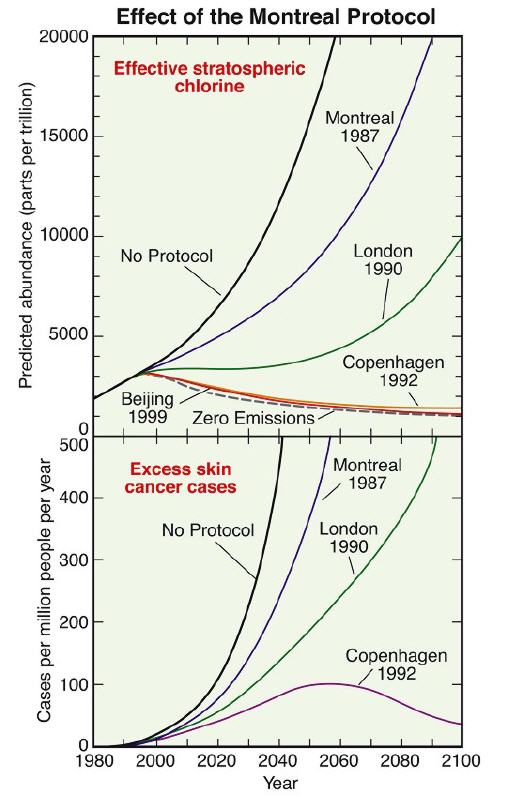The Montreal protocol and its amendments
In order to mitigate the ozone depletion caused by the halogen compounds (CFCs and bromine containing species (halons)) the Montreal protocol “on substances that deplete the ozone layer” was adopted on September 16, 1987. The countries ratifying the Montreal protocol committed themselves to reducing the production and consumption of 5 CFC und and 3 halon compounds. According to the protocol the production and consumption of the 5 regulated CFCs was to be reduced to zero by January 1, 1996. The production and consumption of the regulated halons should be reduced to zero by January 1, 1994. For developing countries with a per capita consumption of the regulated substances below a certain threshold (0.3 kg per year) the deadlines would be deferred by up to 10 years.
The Montreal protocol was complemented by a series of amendments in the following years (London 1990, Copenhagen 1992, Vienna 1995, Montreal 1997, und Bejing 1999, see Figure 3). These amendments extended the list of regulated chemical species or introduced control measures for the trade with regulated substances. The Montreal protocol and its amendments have been ratified by more than 190 countries.
The effect of the Montreal protocol is already measurable: The atmospheric abundances of several regulated species decreased in the lower atmosphere since mid of the 1990s (e.g., CFC 11). Moreover, the abundances of species with longer atmospheric lifetimes (e.g., CFC 12) do not increase anymore and are expected to decrease over the next years. At the end of the 1990s satellite measurements showed that the stratospheric chlorine load does not increase anymore, but decreases slowly.

|
- Fig. 3:
- The effect of the Montreal protocol and its amendments on future changes in the stratospheric chlorine loading. Only after the Copenhagen amendments in 1992 a reduction in the stratospheric chlorine budget was expected in the future. The changes in stratospheric chlorine influence ozone depletion and UV-B radiation at the surface that is responsible for excess skin cancer (from WMO/UNEP Scientific Assessment of Ozone depletion, 2006, Chapter: Twenty Questions, and Answers about the Ozone Layer: Update 2006)
(next page: Ozone and climate)
|
Institute of Environmental Physics (IUP) Institut of Remote Sensing (IFE) University of Bremen, Otto-Hahn-Allee 1 28359 Bremen Deutschland contact to the IUP |

|

|